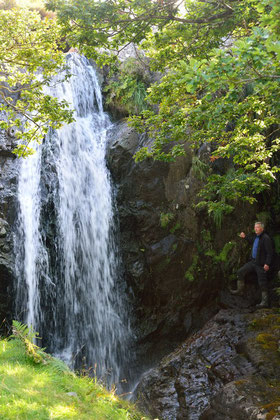Nature at it's purest: A special area of conservation

The natural heritage of the lost Valley is unsurpassed and as a consequence it has been designated as a 'Natural Heritage Area' and more recently a 'Special Area of Conservation' Under the European Habitats Directive.
The continued preservation of The Lost Valley is a priority for the Bourke family. Public access is carefully managed. Only pre-booked guided tours are permitted. Entry is restricted to one group per day. Groups are led along a green road. This ensures the protection of sensitive eco-systems and minimises disruption of wildlife, while allowing the traditional sheep-farming that created and sustains these eco-systems to continue. It also ensures that all visitors can experience the unique wilderness aspect of The Lost Valley.
On the northern boarder of the lost valley farm is the impressive Silver Strand beach which in the past has been classified as the third finest beach in Europe. In fact like the lost valley itself the beach has previously been used as a location for both films and advertisements.
To the east towering overhead is Mweelrea mountain (from the Gaelic Maol Ri, meaning "The bald king") the highest mountain in the west of Ireland. Home to the famed Doulough famine pass.
On the southern boarder of the lost Valley lies Irelands only fjord Killary harbour (An Caoláire Rua, in Gaelic) . This fjord which runs inland for 16km (10miles) has previously been classed as one of the top ten most spectacular fjords in Europe. To the west is the Wild Atlantic.
Rich Flora: Along the walk there is a lot to discover

Surviving near the ruined houses in the Valley are a number of old apple trees. Nature has reclaimed its own however and nowadays semi-native woodlands of ash, oak, hazel and rowan trees surround the houses. During the summer season the ruins are engulfed by a perfusion of braken and wild flowers.
Naturally occurring flora found in the Valley includes, Holly, Whitethorn, Haw, Silver Birch, Myrtle, Aspen, Furze, Juniper,`Willow, Bell Heather, Ivy, Marsh marigolds, Juncus sp., Wild thyme, Dandelion, Flag iris, Wood sorrel, moss, Wild mint, Grey lichen, Red lichen, Oxalis, Bugle, Mountain thyme, Celandine,fuschia, montbretia, Bog myrtle, Salix sp., Insect eating butterwort, Ferns, Bracken, Pondweed, marram and sea lyme grass, although this list is by no means exhaustive.
JUST GO! Tripadvisor Review
This is a must see if you are in Mayo. Stunning views and a hugely informative experience. Gerry as a guide is a fountain of knowledge in all things famine related. He has created a beautiful walkway around his own land through a famine village. Spectacular scenery of The Silver Strand and Killary Fjord on a sunny day - there's nothing better. Tea and biscuits in the old house near the finish is a nice touch. Best money you'll spend all year! Would highly recommend.
Date of experience: August 2020
If you do nothing else in Mayo you must do this!!! Tripadvisor Review
What a brilliant and wonderful outing, highly recommended for all. Be prepared for lots of walking but at a leisurely pace surrounded by stunning scenery. You will learn about the history of the area which has been well researched and told with charismas and charm. The stories of those that have gone before, stories often untold but should not be forgotten. An enlightening, entertaining and memorable day. Bring your cameras because the views are out of this world!
Date of Experience: August 2023
Contact Us
Bourke Family
Phone: + 353 (0) 85 1139977
Email: info@thelostvalley.ie

